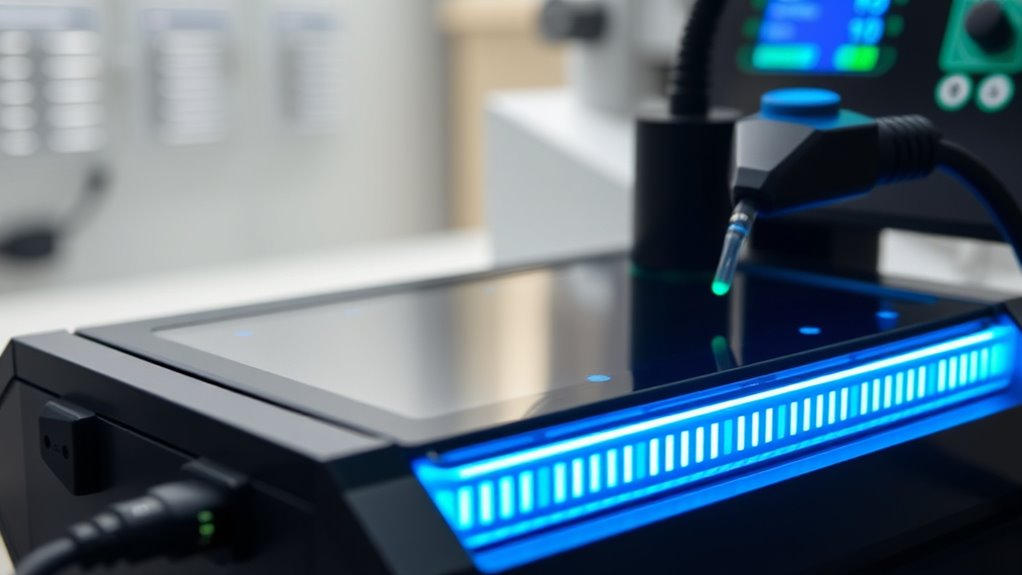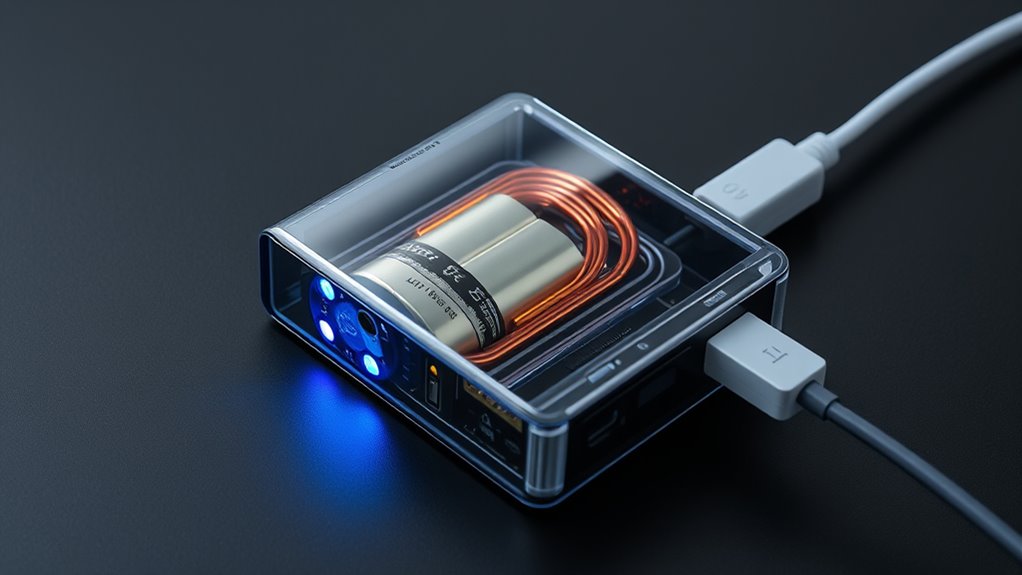To guarantee safety and efficiency in recovery devices, it’s important to understand advanced battery tech, especially fast charging. Fast charging saves time but can generate excess heat, so look for batteries with safety features like thermal cutoffs and voltage regulation. Proper handling, using compatible chargers, and monitoring battery health help extend lifespan and prevent risks. If you keep these tips in mind, you’ll better understand how cutting-edge battery solutions keep your devices safe and reliable.
Key Takeaways
- Advanced battery tech enhances safety features like thermal cutoffs and voltage regulation to prevent overheating during fast charging.
- Proper handling and using compatible chargers extend battery lifespan and reduce safety risks in recovery devices.
- AI monitoring systems proactively track battery health, alerting users to potential safety or performance issues.
- Fast charging increases heat generation, requiring safety mechanisms to mitigate overheating and prevent damage.
- Regular inspection and maintenance ensure batteries remain safe, reliable, and efficient over the device’s lifespan.

Battery technology plays a crucial role in the effectiveness of recovery devices, ensuring they operate reliably when you need them most. When you’re relying on these devices, whether during a critical moment or routine maintenance, their battery performance directly impacts their readiness and efficiency. Two key aspects to evaluate are battery lifespan and charging efficiency, both of which influence how well your recovery device functions over time.
Reliable recovery devices depend on advanced battery tech, ensuring durability, efficiency, and safety when it matters most.
Battery lifespan determines how long your device’s battery remains functional before it starts to degrade. A longer-lasting battery means fewer replacements and less downtime, so you can trust that your recovery device will be ready whenever you need it. Modern battery technologies, like lithium-ion and lithium-polymer, are designed to extend lifespan by minimizing capacity loss over repeated charge cycles. Proper care—such as avoiding extreme temperatures and not overcharging—can further prolong battery life, ensuring your device remains dependable for years.
Charging efficiency is another critical factor. Fast charging capabilities are increasingly common, allowing you to quickly replenish your device’s battery during short breaks or when time is limited. Efficient charging not only saves you time but also helps maintain the health of the battery. High-quality batteries and advanced charging circuits optimize energy transfer, reducing heat buildup and preventing damage that can shorten battery lifespan. When your recovery device supports fast charging, it’s important to use compatible chargers and cables to avoid compromising safety or performance. Properly managed charging cycles help preserve battery integrity, ensuring that each charge delivers maximum capacity without stressing the battery.
Additionally, integrating AI-powered monitoring can help track battery health and alert you to potential issues before they become critical, further enhancing safety and reliability.
Safety considerations are closely linked to battery technology. Fast charging, while convenient, can generate excess heat if not properly managed, increasing the risk of overheating or even fire. Manufacturers incorporate safety features like thermal cutoffs, voltage regulation, and protective circuitry to mitigate these risks. When handling your recovery device, always follow the manufacturer’s guidelines for charging and storage to prevent accidents caused by faulty or incompatible chargers. Regularly inspecting the battery for swelling or damage can also help you catch potential issues early, keeping you safe and maintaining device performance.
Frequently Asked Questions
How Do Fast Charging Batteries Impact Device Lifespan?
Fast charging batteries can shorten your device’s lifespan by increasing battery degradation. When you frequently use fast charge, it accelerates the number of charge cycles your battery undergoes, which wears it out faster. The heat generated during rapid charging also contributes to faster wear. To extend your device’s lifespan, avoid constant fast charging and try to stick with slower, more gradual charging methods whenever possible.
What Safety Features Prevent Battery Overheating During Rapid Charge?
You’re protected during rapid charging by safety features like thermal regulation and overcurrent protection. Thermal regulation continuously monitors and manages the battery’s temperature, preventing overheating. Overcurrent protection cuts off power if current exceeds safe limits, avoiding damage and potential hazards. These features work together to guarantee safe, efficient fast charging, giving you peace of mind while your device quickly recharges without risking overheating or safety issues.
Are There Specific Battery Chemistries Safer for Recovery Devices?
You should look for recovery devices with lithium iron phosphate (LiFePO4) battery chemistry, as it’s inherently safer due to its stability and lower risk of thermal runaway. Good thermal management systems further enhance safety by effectively dissipating heat during rapid charging. Combining these battery chemistries with robust thermal management guarantees safer fast charging, reducing overheating risks and protecting both the device and user during recovery operations.
How Does Temperature Affect Fast Charging Efficiency and Safety?
Temperature plays a vital role in fast charging efficiency and safety. When ambient conditions are ideal, thermal regulation helps prevent overheating, ensuring safe and quicker charging. If temperatures are too high or low, charging slows down to protect the battery, reducing efficiency. You should always monitor thermal regulation and ambient conditions to avoid safety risks like thermal runaway, which can cause damage or failure during fast charging.
What Advancements Are Emerging in Battery Technology for Recovery Devices?
You’ll see advancements in battery technology for recovery devices that extend battery lifespan and improve safety, such as solid-state batteries and advanced lithium-ion cells. These innovations enable faster charging while maintaining safety standards. Additionally, improved charging infrastructure supports more efficient power delivery, reducing downtime. These developments help guarantee your recovery devices are more reliable, longer-lasting, and safer to use during critical moments.
Conclusion
As you harness the power of advanced battery technology in recovery devices, envision a swift, confident surge of energy illuminating your path forward. Fast charging becomes your trusted ally, seamlessly fueling your efforts, while safety considerations act as a sturdy shield guarding every step. With each recharge, you access a world where innovation and caution dance in harmony, empowering you to navigate challenges with clarity and resilience—your journey fueled by technology that’s as reliable as it is swift.









